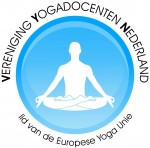Doing Yoga For Stroke Recovery – A Patient’s Story
This article was translated from “Na herseninfarct weer in de benen met yoga” (2017)
In April 2014, Henk Miltenburg woke up in a San Francisco hospital. He had been in a coma for ten days following a stroke. At the time, he was 53, father of two sons, and a board member, responsible for the logistics of a communication devices multinational. He currently works on his recovery, having turned to yoga to regain control over his legs and body. We visit him in his home garden in Ommen, the Netherlands.
Henk takes a deep breath: “After a stroke, you have to relearn everything. Talking, eating, standing up; everything’s incredibly difficult. Your balance is off, your eye-hand coordination is gone. When I woke up, I had no idea what had occurred. I only thought, ‘What happened?’ That was it.”
Rehabilitation in the USA
“Eventually you start to realize what happened to you. I was lucky. US medical care is great if you have the right insurance, which I had. But what I didn’t know at the time, was that this only applied to medical procedures and the IC. My neurologist was excellent, but my insurer wasn’t interested in rehabilitation at all. And, from what I experienced, others aren’t either. Most of the staff available barely spoke English. So, as soon as I got disconnected from the machines, my medical care went downhill.”
Private rehabilitation therapist
After being treated in the hospital for a month, he started on a rehabilitation program provided by his insurance. It didn’t work out. And in the US, that means you’re on your own. Henk and his wife decided to hire a private rehabilitation therapist, a lady named Pam Hansen. Their decision paid off. With great care and dedication, she helped him start his recovery process.
Reintegrating at work
The company he worked for, Polycom, was extremely helpful. Henk could reintegrate at his own pace. But driving to work, about 40 kilometers, wasn’t easy. He wasn’t able to drive himself and depended on rides from others. Fortunately, he was able to do a lot of work from home. “My work mainly consists of talking, and that already went quite well. So, I was on my phone and computer all day. My workdays started early, first talking to the Dutch office, then to the US office, and ended in the evening, discussing problems concerning the offices in Asia. In emergency situations I would get late-night calls, asking me to solve hassles with customs, for instance.”
Moving back to the Netherlands
“In and around the house, we managed quite well, but we noticed that, socially, we were becoming increasingly isolated. American colleagues came by at first, but after a while their visits stopped. Our children also had a hard time, worrying about me. After six months of growing loneliness, Angeline, my wife, felt it was time to move back to the Netherlands. We looked for a suitable house near Wierden, where family and friends lived, and settled in Ommen.”
Making progress, whatever it takes
Henk’s treating physician in the Netherlands immediately concluded he needed full rehabilitation. Henk was presented with a simple treatment plan. From wheelchair, to walker, to walking stick, and eventually to walking independently. His Dutch therapists were optimistic. He was given various treatment options, but they mainly were forms of physiotherapy and swimming therapy. Henk improved slowly, but wanted it to go faster. He still couldn’t stand upright for a long time and could only walk up a hill but not down. On top of that, he was constantly afraid of falling and he was told to forget about jogging or driving ever again. He wanted to make progress, whatever it took.
Yoga as therapy
Henk: “I then contacted Pam again. To my surprise, she advised me to do yoga. It didn’t seem like my cup of tea. I thought yoga was for tree-huggers and hippies, way too flimsy. But I had a lot of faith in Pamela and was willing to try anything. So, I Googled for yoga studios in Ommen. The answer was at the top of the page: Irene Vos from Yoga Ommen. I sent her an email and spoke to her on the phone that same afternoon. I’ve now had about 15 private sessions, and since I started doing yoga, I’m making much more progress.”
A different approach
“I immediately noticed Irene has a different approach than the other therapists I worked with. During our intake session, she gave me a clear trajectory with goals and objectives. After 3 years of tinkering, she was the first person I met who dared to be this clear. Besides being a yoga instructor, Irene is a registered nurse and she is always upfront and honest. And although she is very friendly, she doesn’t feel too sorry for me. She really puts me to work.”
Doing floor poses and bathing in sweat
“And yoga is really tough! I’ll never say it’s flimsy again. The yoga exercises Irene lets me do are intense. I never expected that. The session lasts an hour, that’s all I can handle, and when we’re done, I’m drenched. I often joke about bathing in my own sweat.”
“Floor poses are an important part of my therapy. We started doing them because I was afraid to stand. We mainly do exercises that activate my corset muscles. You use your corset muscles, or inner core, to stabilize your torso. Now that I’ve made some progress, I also do sitting and standing postures, like candle and tree, to improve my balance. It’s quite different from swimming therapy, where all I do is walk in waist-deep water. That doesn’t help me one bit.”
Critical Alignment Yoga and Therapy
Irene helps Henk by tailoring the yoga sessions completely to him and his situation. The method used is Critical Alignment Yoga and Therapy. This is a type of yoga that aims to re(gain) control over posture and muscles, and to restore the connection between body and mind, improving your self-healing ability.
Critical Alignment Yoga can help treat neck injuries, shoulder complaints, pelvic and back problems, but also residual symptoms after stroke and other non-congenital brain injuries. It may also be beneficial for non-physiological disorders, such as stress, fatigue, and burnout.
At-home rehabilitation space is easily set up with the help of instructions and simple props like cushions, blocks, belts, rubber strips, and headstand benches. It’s essential that the client keeps doing the exercises independently between sessions.
Setting goals
“We end our sessions with 10 minutes of savasana, a pose of total relaxation. It helps my body process the exercises. ” He continues: “So, right now, I receive three types of therapy per week: Swimming therapy on Monday, yoga therapy on Wednesday, and regular physiotherapy on Friday. But yoga helps me most. I set myself a goal: I want to be able to go for a jog again at the end of 2017 and to drive again soon after. That’s what I’m going for!”
Critical Alignment Yoga can help with the following health conditions:
- Physical complaints originating in the spine: back pain, neck pain, whiplash, RSI (CANS), pain in shoulders, hernia, sciatica, pelvic complaints, but also spine-related complaints in arms and legs (appearance, pain, loss of strength).
- Stress-related complaints such as breathing disorders, hyperventilation, fatigue, burnout.
- Critical Alignment Yoga can also be used preventively and for posture correction.
For those interested
Are you interested in yoga and would you like to experience the benefits of yoga yourself? You can! The exercises are easy to learn and (with a bit of practice) can also be done at home. If you don’t live in or nearby Ommen, our Online Back Care Basics program offers a great alternative! Or join our free 6-day challenge “From Back Pain to Back Gain” first, and discover what yoga can do for you!
If you live in the neighborhood or are visiting Ommen, feel free to visit us. Or sign up for a trial class or a private class.


